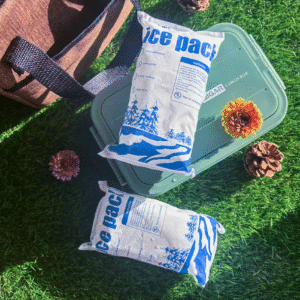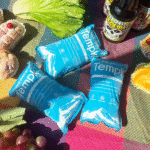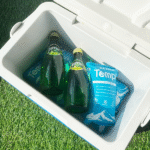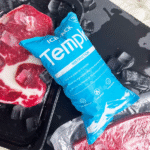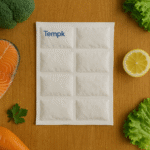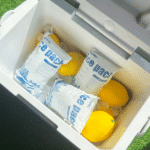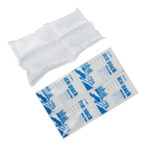Pacote de gelo seco em promoção: Como dimensionar e enviar 2025?
Se você precisar de chegadas sólidas e congeladas com menos reclamações, a direita Vendo bolsa de gelo seco emparelhado com vitórias de embalagem inteligente. Dentro do primeiro 50 palavras, você aprenderá como escolher uma bolsa de gelo seco à venda para pistas de 24 a 72 horas, quando mudar para pacotes de gel PCM, e como passar PI 954 aceitação sem dores de cabeça. Dicas do mundo real, um seletor rápido, e 2025 tendências estão incluídas.
-
Como dimensionar um Vendo bolsa de gelo seco para pistas de 24 a 72 horas usando uma ferramenta de decisão rápida e buffers de pior caso
-
O que PI 954 conformidade exige em 2025 (ventilação, Peso líquido, verificações de aceitação)
-
Quando mudar de gelo seco para pacotes de gel PCM para reduzir riscos e custos
-
Como estruturar a página do seu produto para classificar para “venda de bolsa de gelo seco” em 2025
Como dimensionar corretamente uma bolsa de gelo seco à venda para pistas de 24 a 72 horas?
Resposta curta: Mapear tempo de trânsito, temperatura alvo, isolamento, e volume livre – em seguida, adicione um buffer de segurança de 20–30%. Coloque pacotes ao redor da carga útil, mantenha as aberturas de ventilação abertas, e verifique com registradores de dados em dois testes. Esta abordagem estabiliza a temperatura central e reduz as taxas de exceção em pistas congeladas.
Explicação mais longa: Comece com três entradas: Duração da remessa (mais atrasos), massa do produto/temperatura inicial, e o nível de isolamento da caixa. Para carga ultracongelada (≤–40 °C) Escolha um Vendo bolsa de gelo seco; para –20 °C ou 2–8 °C, Os tijolos PCM geralmente apresentam uma curva mais plana com menos papelada. Em novas pistas, qualifique-se duas vezes com registradores antes de padronizar sua lista de materiais (Bom).
Quando você deve usar pacotes de gel PCM?
Detalhe: Usar PCM –21°C para alimentos congelados quando a ultracongelação não é obrigatória; PCM +5 °C para vacinas/produtos biológicos a 2–8 °C; e PCM +18/+22 °C para faixas de temperatura ambiente controlada. Híbridos (gelo seco pequeno + PCM) suavizar a curva, reduzir o gelo seco total, e pode reduzir o peso declarado de mercadorias perigosas.
| Mapa de casos de uso | Líquido de arrefecimento recomendado | Ponto de ajuste típico | O que isso significa para você |
|---|---|---|---|
| ≤–40 °C, pistas de verão | Vendo bolsa de gelo seco | –78,5 ° C. (sublime) | Potência fria máxima; garantir a ventilação |
| –25 °C a –15 °C | PCM ou gelo seco | –21 °CPCM | Perfil de perigo mais baixo; tijolos reutilizáveis |
| 2–8 °C biológicos | Pacote de gel PCM | +5 °CPCM | Platô de temperatura plana; menos excursões |
| 15–25°C CRT | Pacote de gel PCM | +18/+22 °CPCM | Evita picos de calor sem resfriamento excessivo |
Dicas práticas que você pode aplicar hoje
-
Trânsito ≥36h? Aumente a massa do refrigerante em 20–30% ou adicione um forro reflexivo.
-
Origem quente/verão? Pré-condição por mais tempo; reduzir o espaço livre.
-
Volumetria apertada? Use tijolos PCM finos e um menor Vendo bolsa de gelo seco somente quando for necessário ultracongelar.
-
Novas pistas? Execute dois pilotos com registradores, então bloqueie seu BOM.
Caso do mundo real: Um transportador de frutos do mar substituiu dois 5 lb de pacotes de gelo seco com um 5 lb de gelo seco mais dois tijolos de PCM a –21 °C para uma pista de 48 horas. Produto chegou certinho; classe de peso de gelo seco caiu; o custo das encomendas caiu cerca de 9%.
Quais regulamentos se aplicam a uma bolsa de gelo seco à venda em 2025?
Resposta curta: Gelo seco (E 1845) precisa de embalagem ventilada, marcação de peso líquido, e a 2025 lista de verificação de aceitação sob PI 954. Muitos operadores exigem uma verificação de aceitação de gelo seco na licitação. Rotulagem e ventilação não são negociáveis.
Explicação mais longa: Mantenha as aberturas de ventilação desobstruídas para que o CO₂ possa escapar; nunca sele gelo seco em revestimentos apertados. Marque a caixa externa com “Dióxido de carbono, sólido (gelo seco), E 1845, ___ kg líquidos.” Utilize o operador 2025 lista de verificação de aceitação e guarde uma cópia nas estações de envio. Para produtos biofarmacêuticos de 2–8 °C, registrar temperaturas mínimas/máximas durante a qualificação e corridas ao vivo.
Etapas seguras de manuseio e embalagem (POP pronto para cópia)
-
Pré-condicione bolsas de gelo seco (≤–20 °C) e PCMs em seus pontos de ajuste.
-
Centralize o produto; cercar com refrigerante; mantenha os caminhos de ventilação abertos.
-
Marca A 1845 e peso líquido de gelo seco na caixa externa.
-
Anexe a lista de verificação de aceitação; verifique na entrega.
-
Use registradores de dados para novas pistas ou mercadorias de alto valor.
Os pacotes de gel PCM substituirão o pacote de gelo seco vendido em algumas pistas?
Resposta curta: Muitas vezes sim para 2–8 °C e –20 °C. PCMs são reutilizáveis e não perigosos; eles cortaram a papelada. Para pistas ultracongeladas ou muito quentes, um Vendo bolsa de gelo seco ainda ganha. Os híbridos podem proporcionar tempos de espera mais longos com menos CO₂.
Explicação mais longa: PCMs absorvem calor em um ponto de fusão fixo, criando um patamar estável – ideal quando o congelamento é arriscado. O gelo seco traz um poder frio incomparável e pode beneficiar certos alimentos. Escolha com base na sensibilidade da carga útil, variabilidade da pista, e sobrecarga de conformidade.
Modelo de especificações que você pode adaptar
| SKU | Rede de gelo seco da rede | Ajuste de caixa (L) | Meta de tempo de espera | Melhor para |
|---|---|---|---|---|
| DI-5 | 2.3 kg (5 Libra) | 3–6L | 24–36 h | Frutos do mar do primeiro dia, sobremesas |
| DI-10 | 4.5 kg (10 Libra) | 6–10 litros | 36–48 h | Pistas de verão multizonas |
| DI-15 | 6.8 kg (15 Libra) | 10–14 litros | 48–72 h | Longo curso, picos de calor |
| Eixo | 3.6 kg DI + 2 kg PCM | 10–14 litros | 48–72 h | Congelado com temperaturas de borda mais suaves |
SEO na página: como você se classifica para “venda de bolsa de gelo seco” em 2025?
Resposta curta: Coloque a frase exata em seu H1, dentro do primeiro 50 palavras, e em ≥50% dos H2s; mantenha a densidade ~ 1,5–2%; adicionar artigo + Programação da página de perguntas frequentes; otimizar a experiência do usuário (INP, PCL, CLS).
Projeto que você pode copiar:
-
Herói: “Promoção de pacote de gelo seco – Compre o tamanho certo para pistas de 24 a 72 horas.”
-
Ferramenta de decisão: 30-segunda calculadora.
-
Guia Conformidade: Pi 954 destaques + modelo de peso líquido.
-
Tabela de especificações & Perguntas frequentes: Abordar caudas longas (“Quanto gelo seco por remessa?”, “O gelo seco é permitido em aviões?”).
-
CTA: “Obtenha uma cotação específica da pista em 2 horas."
30-segunda ferramenta de decisão (incorporar em sua página)
2025 desenvolvimentos e tendências em venda de gelo seco e SEO
Visão geral da tendência: Intensificação da fiscalização contra conteúdo escalado/parasita; útil, o conteúdo que prioriza as pessoas e a forte experiência da página continuam a ser recompensados. INP substituído FID nos vitais da Web central (Março 12, 2024) e continua sendo um sinal UX importante; transportadoras mantêm 2025 listas de verificação de aceitação de gelo seco para a ONU 1845.
Último em um olhar
-
Política & classificação: Repressão ao abuso de reputação do site e abuso de conteúdo em escala; mantenha o conteúdo dentro do tópico e útil.
-
Desempenho de experiência do usuário: Apontar para “Bom” no LCP, INP, CLS em dados do mundo real.
-
Tecnologia da cadeia de frio: Híbridos (gelo seco + PCM) e o registro de IoT estão aumentando para estender o tempo de espera e reduzir a massa de CO₂.
Insight de mercado: Os compradores querem menos exceções e documentação mais simples, impulsionando a adoção de PCM para temperaturas de 2 a 8 °C e cargas híbridas para rotas congeladas, especialmente no comércio eletrônico de frutos do mar e produtos farmacêuticos especializados.
Perguntas frequentes
Q1: Quanto pacote de gelo seco para venda eu preciso para 24-36 horas?
Comece com 2–3kg por 5–7 L de espaço de produto; adicionar 20–30% para pistas quentes ou picos de verão. Validar com duas execuções piloto.
Q2: É legal enviar gelo seco por via aérea em 2025?
Sim – use embalagens ventiladas, marca E 1845 com peso líquido, e siga o 2025 lista de verificação de aceitação em Pi 954.
Q3: Posso misturar PCM e uma bolsa de gelo seco à venda?
Sim – os híbridos estabilizam as bordas, prolongar o tempo de espera, e pode reduzir o peso declarado do gelo seco. Teste antes de dimensionar.
Q4: Eu preciso de registradores de dados?
Fortemente recomendado para novas pistas ou bens de alto valor; eles se pagam rapidamente evitando reclamações.
Resumo & Recomendações
Recapitular: Dimensione corretamente o seu Vendo bolsa de gelo seco por hora da pista, temperatura alvo, isolamento, e volume livre. Use PCM para 2–8 °C e muitas pistas de –20 °C; use híbridos para rotas ultracongeladas ou longas. Siga PI 954 para remessas aéreas e validar com registradores de dados. Mantenha a página do seu produto focada nas pessoas e com rapidez.
PRÓXIMOS PASSOS (CTA):
-
Execute dois pilotos com registradores de dados na sua pista mais quente.
-
Publique o seletor rápido e a guia de conformidade na página do seu produto.
-
Solicitar a cotação específica da pista- retornaremos estimativas de tamanho e tempo de espera dentro 2 horas.
Estratégia de links internos (adicione-os como links internos)
-
Calculadora de gelo seco
-
Seletor PCM
-
Guia de isolamento
-
Centro de Conformidade
-
Estudos de caso
Recomendação de dados estruturados
Incluir:
-
Artigo, Página de perguntas frequentes, e Howto esquema.
-
Palavras-chave: “venda de bolsa de gelo seco”, “transporte de gelo seco”, “PI 954”, “Pacote de gel PCM”, “cadeia de frio”.
-
Datas de publicação adequadas, autor, e imagens no formato JSON-LD.
Sobre Tempk
Projetamos embalagens validadas para cadeia de frio e soluções de controle de temperatura para o setor farmacêutico, Biotech, e comida premium. Nossos engenheiros mapeiam pistas, simular ambientes de pior caso, e refrigerantes do tamanho certo - muitas vezes reduzindo a massa do refrigerante 10–20% protegendo ao mesmo tempo a qualidade do produto. Vamos construir juntos uma cadeia de frio mais inteligente.






